Impact of NH3 Emissions on Particulate Matter Pollution in South Korea: A Case Study of the Seoul Metropolitan Area
Abstract
:1. Introduction
2. Data and Methodology
2.1. Ground Measurements
2.2. Cross-Track Infrared Sounder Data
3. Results
4. Discussion
Author Contributions
Funding
Data Availability Statement
Acknowledgments
Conflicts of Interest
References
- Kim, H.C.; Kim, S.; Kim, B.-U.; Jin, C.-S.; Hong, S.; Park, R.; Son, S.; Bae, C.; Bae, M.; Song, C.; et al. Recent increase of surface particulate matter concentrations in the Seoul Metropolitan Area, Korea. Sci. Rep. 2017, 7, 4710. [Google Scholar] [CrossRef] [PubMed]
- Yeo, M.J.; Kim, Y.P. Trends of the PM10 concentrations and high PM10 concentration cases in Korea. J. Korean Soc. Atmos. Environ. 2019, 25, 249–264. [Google Scholar] [CrossRef]
- Sun, Y.; Jiang, Q.; Wang, Z.; Fu, P.; Li, J.; Yang, T.; Yin, Y. Investigation of the source and evolution processes of severe haze pollution in Beijing in January 2013. J. Geophys. Res.-Atmos. 2014, 119, 4380–4398. [Google Scholar] [CrossRef]
- Zheng, G.J.; Duan, F.K.; Su, H.; Ma, Y.L.; Cheng, Y.; Zheng, B.; Zhang, Q.; Huang, T.; Kimoto, T.; Chang, D.; et al. Exploring the severe winter haze in Beijing: The impact of synoptic weather, regional transport and heterogeneous reactions. Atmos. Chem. Phys. 2015, 15, 2969–2983. [Google Scholar] [CrossRef]
- Seo, J.; Kim, J.Y.; Youn, D.; Lee, J.Y.; Kim, H.; Lim, Y.B.; Kim, Y.; Jin, H.C. On the multiday haze in the Asian continental outflow: The important role of synoptic conditions combined with regional and local sources. Atmos. Chem. Phys. 2017, 17, 9311–9332. [Google Scholar] [CrossRef]
- NIER. Annual Report of Air Pollution in 2017; National Institute of Environmental Research: Incheon, Korea, 2018. (In Korea) [Google Scholar]
- Seo, J.; Lim, Y.B.; Youn, D.; Kim, J.Y.; Jin, H.C. Synergistic enhancement of urban haze by nitrate uptake into transported hygroscopic particles in the Asian continental outflow. Atmos. Chem. Phys. 2020, 20, 7575–7594. [Google Scholar] [CrossRef]
- NIER. Introduction to the KORUS-AQ Rapid Science Synthesis Report; National Institute of Environmental Research: Incheon, Korea, 2018. Available online: https://espo.nasa.gov/sites/default/files/documents/KORUS-AQ%20RSSR.pdf (accessed on 15 December 2019). (In Korea)
- Goldberg, D.L.; Saide, P.E.; Lamsal., L.N.; de Foy, B.; Lu, Z.; Woo, J.-H.; Kim, Y.; Kim, J.; Gao, M.; Carmichael, G.; et al. A top-down assessment using OMI NO2 suggests an underestimate in the NOx emissions inventory in Seoul, South Korea, during KORUS-AQ. Atmos. Chem. Phys. 2019, 19, 1801–1818. [Google Scholar] [CrossRef]
- Huang, R.-J.; Zhang, Y.; Bozzetti, C.; Ho, K.-F.; Cao, J.-J.; Han, Y.; Daellenbach, K.R.; Slowik, J.G.; Platt, S.M.; Canonaco, F.; et al. High secondary aerosol contribution to particulate pollution during haze events in China. Nature 2014, 514, 218. [Google Scholar] [CrossRef]
- Shen, G.; Xue, M.; Yuan, S.; Zhang, J.; Zhao, Q.; Li, B.; Wu, H.; Ding, A. Chemical compositions and reconstructed light extinction coefficients of particulate matter in a mega-city in the western Yangtze River Delta, China. Atmos. Environ. 2014, 83, 14–20. [Google Scholar] [CrossRef]
- Tao, J.; Gao, J.; Zhang, L.; Zhang, R.; Che, H.; Zhang, Z.; Lin, Z.; Jing, J.; Cao, J.; Hsu, S.C. PM2.5 pollution in a megacity of southwest China: Source apportionment and implication. Atmos. Chem. Phys. 2014, 14, 8679–8699. [Google Scholar] [CrossRef]
- Park, S.; The Issues of Hazardous Air Pollutants Managements in Korea. Environment Media. 31 July 2019. Available online: http://www.ecomedia.co.kr/news/newsview.php?ncode=1065569200778326 (accessed on 22 October 2019). (In Korea).
- Chu, B.; Zhang, X.; Liu, Y.; He, H.; Sun, Y.; Jiang, J.; Li, J.; Hao, J. Synergetic formation of secondary inorganic and organic aerosol: Effect of SO2 and NH3 on particle formation and growth. Atmos. Chem. Phys. 2016, 16, 14219–14230. [Google Scholar] [CrossRef]
- Choi, J.; Park, R.J.; Lee, H.M.; Lee, S.; Jo, D.S.; Jeong, J.I.; Henze, D.K.; Woo, J.H.; Ban, S.J.; Lee, M.D.; et al. Impacts of local vs. trans-boundary emissions from different sectors on PM2.5 exposure in South Korea during the KORUS-AQ campaign. Atmos. Environ. 2019, 203, 196–205. [Google Scholar] [CrossRef]
- Shin, H.J.; Lim, Y.J.; Kim, J.H.; Jung, H.J.; Park, S.M.; Park, J.S.; Song, I.H.; Seo, S.J.; Hong, Y.D.; Han, J.S. The characteristics of long-term high PM episode occurred in Feb. J. Korean Soc. Urban Environ. 2014, 14, 223–232. [Google Scholar]
- Park, J.S.; Lim, Y.; Seo, Y.; Shin, H.; Anh, J.; Lee, S.; Kim, H.; Choi, J.; Sung, M.; Jeon, H.; et al. Study on the Chemical Characteristics of PM2.5 in Case of High Concentration Episode; National Institute of Environmental Research (NIER); Ministry of Environment (KMOE): Sejong, Korea, 2015. (In Korea) [Google Scholar]
- Nault, B.A.; Campuzano-Jost, P.; Day, D.A.; Schroder, J.C.; Anderson, B.; Beyersdorf, A.J.; Blake, D.R.; Brune, W.H.; Choi, Y.; Corr, C.A.; et al. Secondary organic aerosol production from local emissions dominates the organic aerosol budget over Seoul, South Korea, during KORUS-AQ. Atmos. Chem. Phys. 2018, 18, 17769–17800. [Google Scholar] [CrossRef]
- Joint Korean Ministries. The Comprehensive Measures for PM Pollution Management. 2017. Available online: http://www.me.go.kr/home/web/policy_data/read.do?pagerOffset=30&maxPageItems=10&maxIndexPages=10&searchKey=&searchValue=&menuId=10259&orgCd=&condition.deleteYn=N&seq=7053 (accessed on 10 June 2021). (In Korea)
- Korean Law Information Center. Special Act on the Reduction and Management of Fine Dust; Ministry of Government Legislation: Sejong, Korea, 2021. Available online: https://www.law.go.kr/LSW/eng/engLsSc.do?menuId=2&query=ENFORCEMENT%20DECREE%20OF%20THE%20SPECIAL%20ACT%20ON%20THE%20REDUCTION%20AND%20MANAGEMENT%20OF%20FINE%20DUST#liBgcolor2 (accessed on 14 December 2021).
- Choi, H.S.; The Solutions of Mitigating Korean PM Pollutions. Maeil Business News Korea. 18 April 2019. Available online: https://www.mk.co.kr/news/economy/view/2019/04/242507/ (accessed on 18 May 2019). (In Korea).
- Jeong, U.; Kim, J.; Lee, H.; Lee, Y.G. Assessing the effect of long-range pollutant transportation on air quality in Seoul using the conditional potential source contribution function method. Atmos. Environ. 2017, 150, 33–44. [Google Scholar] [CrossRef]
- NIER. National Air Pollutant Emissions in 2015; National Institute of Environmental Research: Incheon, Korea, 2018. (In Korea) [Google Scholar]
- Seinfeld, J.H.; Pandis, S.N. Atmospheric Chemistry and Physics: From Air Pollution to Climate Change, 2nd ed.; John Wiley & Sons: New York, NY, USA, 2006. [Google Scholar]
- Wu, Y.; Gu, B.; Erisman, J.W.; Reis, S.; Fang, Y.; Lu, X.; Zhang, X. PM2.5 pollution is substantially affected by ammonia emissions in China. Environ. Pollut. 2016, 218, 86–94. [Google Scholar] [CrossRef]
- Lee, H.-M.; Park, R.J.; Henze, D.K.; Lee, S.; Shim, C.; Shin, H.J.; Moon, K.J.; Woo, J.-H. PM2.5 source attribution for Seoul in May from 2009 to 2013 using GEOS-Chem and its adjoint model. Environ. Pollut. 2017, 221, 227–384. [Google Scholar] [CrossRef]
- Shin, D.W.; Joo, H.S.; Seo, E.J.; Kim, C.Y. Management Strategies to Reduce PM2.5 Emission: Emphasis-Ammonia; Research Reports of Korea Environment Institute (KEI); KEI: Sejong, Korea, 2017; (In Korea with English abstract). [Google Scholar]
- KMOE & NIER. Guidelines for Installation and Operation of Air Pollution Monitoring Network; Ministry of Environment; National Institute of Environmental Research: Incheon, Korea, 2019. (In Korea) [Google Scholar]
- Han, J.; Lee, M.; Shang, X.; Lee, G.; Emmons, L.K. Decoupling peroxyacetyl nitrate from ozone in Chinese outflows observed at Gosan Climate Observatory. Atmos. Chem. Phys. 2017, 17, 10619–10631. [Google Scholar] [CrossRef]
- Zavyalov, V.; Esplin, M.; Scott, D.; Esplin, B.; Bingham, G.; Hoffman, E.; Lietzke, C.; Predina, J.; Frain, R.; Suwinski, L.; et al. Noise performance of the CrIS instrument. J. Geophys. Res. Atmos. 2013, 118, 13–108. [Google Scholar] [CrossRef]
- Shephard, M.W.; Cady-Pereira, K.E. Cross-track Infrared Sounder (CrIS) satellite observations of tropospheric ammonia. Atmos. Meas. Tech. 2015, 8, 1323–1336. [Google Scholar] [CrossRef]
- Dammers, E.; Shephard, M.; Palm, M.; Cady-Pereira, K.; Capps, S.; Lutsch, E.; Strong, K.; Hannigan, J.W.; Ortega, I.; Toon, G.C.; et al. Validation of the CrIS fast physical NH3 retrieval with ground-based FTIR. Atmos. Meas. Tech. 2017, 10, 2645–2667. [Google Scholar] [CrossRef]
- Viatte, C.; Wang, T.; Van Damme, M.; Dammers, E.; Meleux, F.; Clarisse, L.; Shephard, M.W.; Whitburn, S.; Coheur, P.F.; Cady-Pereira, K.E.; et al. Atmospheric ammonia variability and link with particulate matter formation: A case study over the Paris area. Atmos. Chem. Phys. 2020, 20, 577–596. [Google Scholar] [CrossRef]
- Shephard, M.W.; Dammers, E.; Cady-Pereira, K.E.; Kharol, S.K.; Thompson, J.; Gainariu-Matz, Y.; Zhang, J.; McLinden, C.A.; Kovachik, A.; Moran, M.; et al. Ammonia measurements from space with the Cross-track Infrared Sounder: Characteristics and applications. Atmos. Chem. Phys. 2020, 20, 2277–2302. [Google Scholar] [CrossRef]
- Huang, X.; Qiu, R.; Chan, C.K.; Ravi Kant, P. Evidence of high PM2.5 strong acidity in ammonia-rich atmosphere of Guangzhou, China: Transition in pathways of ambient ammonia to form aerosol ammonium at [NH4+]/[SO42−]=1.5. Atmos. Res. 2011, 99, 488–495. [Google Scholar] [CrossRef]
- Lee, T. Understanding of aerosol formation over South Korea based on in-situ measurements. In On-Line Forum on Fine Particle Research Initiative in East Asia Considering National Differences Project (FRIEND); Seoul, Korea, 2022. [Google Scholar]
- Backes, A.M.; Aulinger, A.; Bieser, J.; Matthias, V.; Quante, M. Ammonia emissions in Europe, part II: How ammonia emission abatement strategies affect secondary aerosols. Atmos. Environ. 2016, 126, 153–161. [Google Scholar] [CrossRef]
- Han, S.H.; Kim, Y.P. Long-term Trends of the concentrations of mass and chemical composition in PM2.5 over Seoul. J. Korean Soc. Atmos. Environ. 2015, 31, 143–156. (In Korea) [Google Scholar] [CrossRef]
- Joint Korean Ministries. The Comprehensive Management Plan on the Fine Dust. 2019. Available online: https://www.cleanair.go.kr/dust/information/policy.do?mode=view&articleNo=20&article.offset=0&articleLimit=10 (accessed on 10 October 2019). (In Korea)
- KMOE. The Study for Basic Plan for Regional Air Quality Management; Ministry of Environment: Sejong, Korea, 2020. (In Korea)
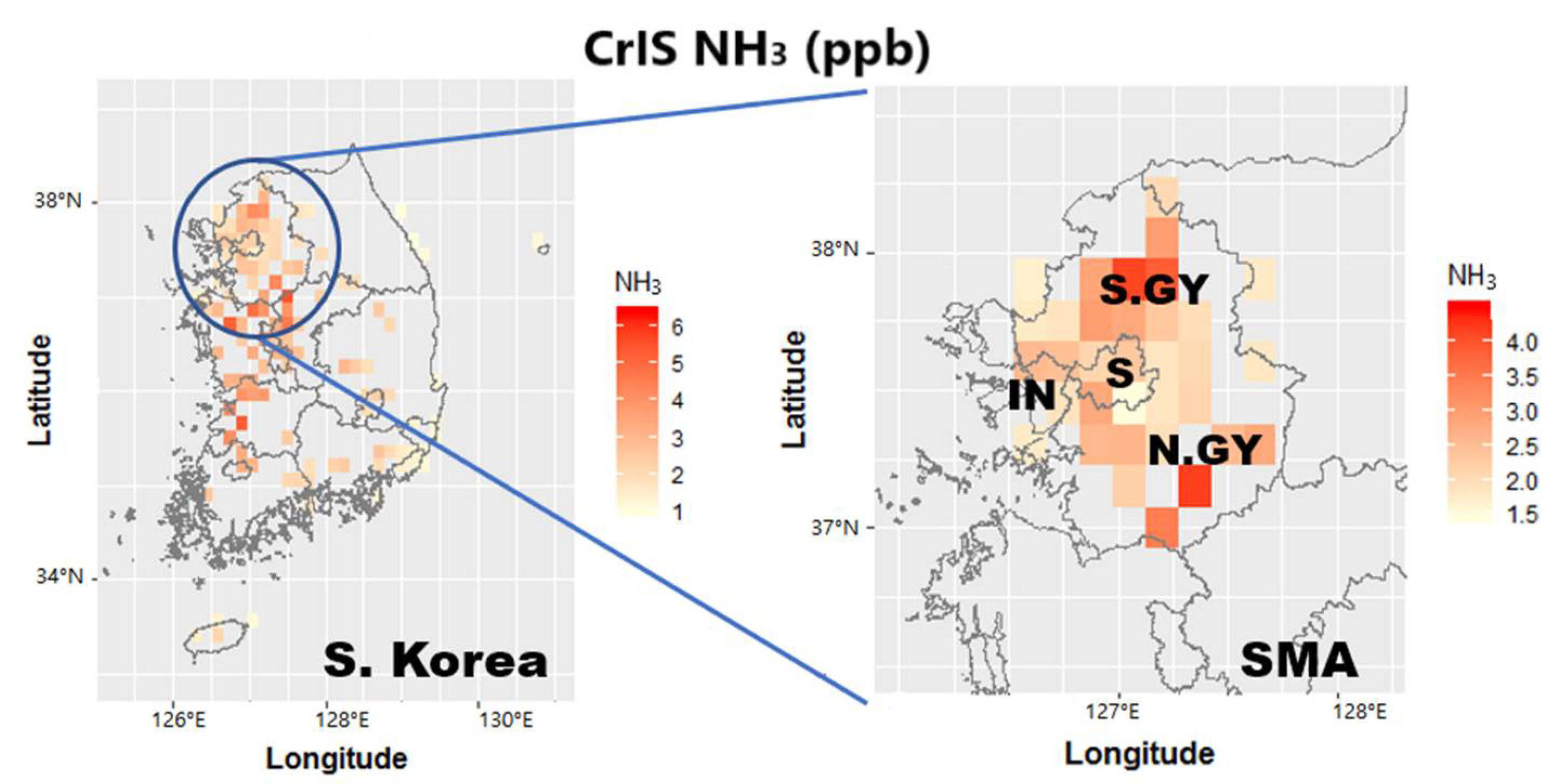
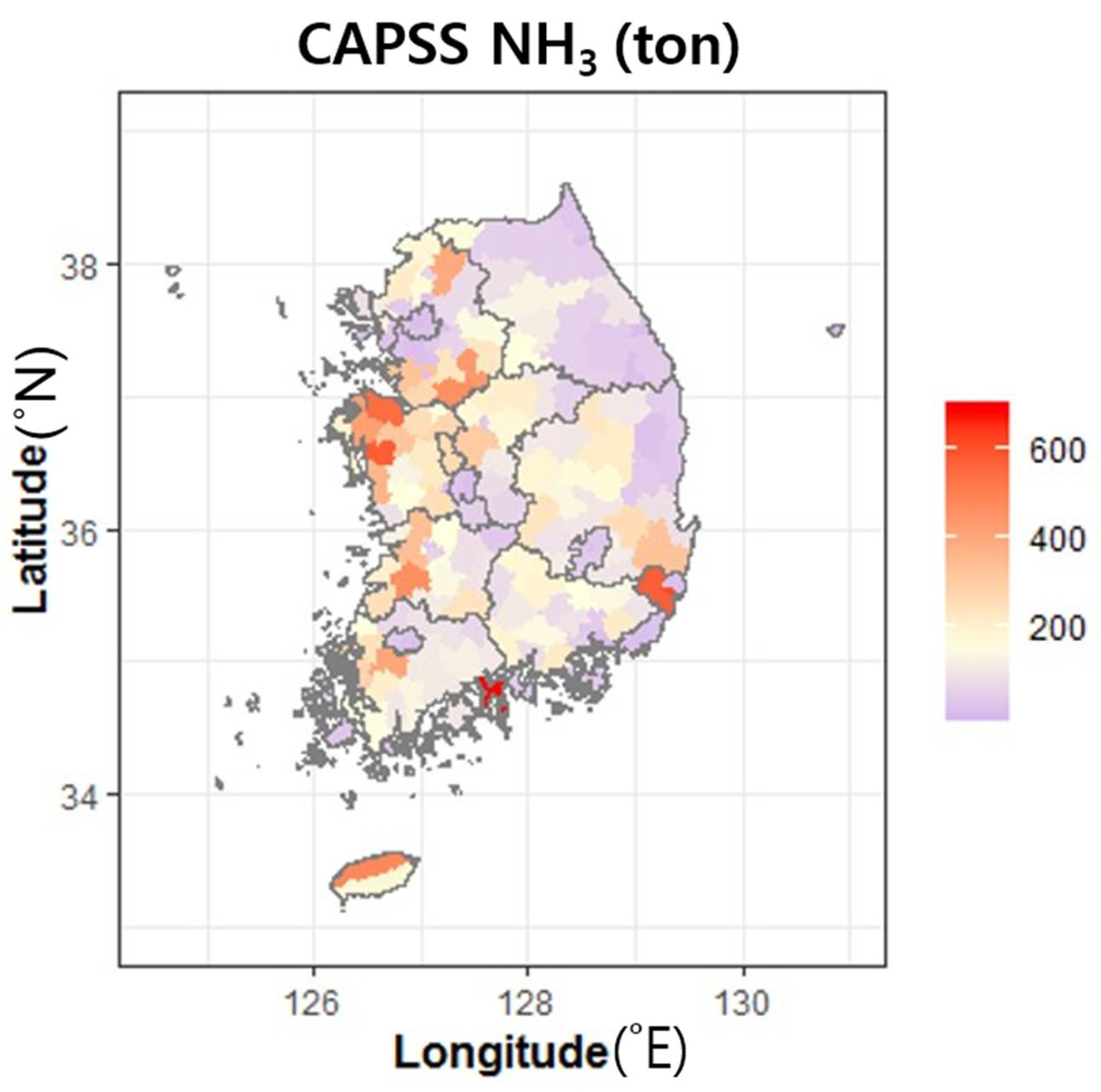
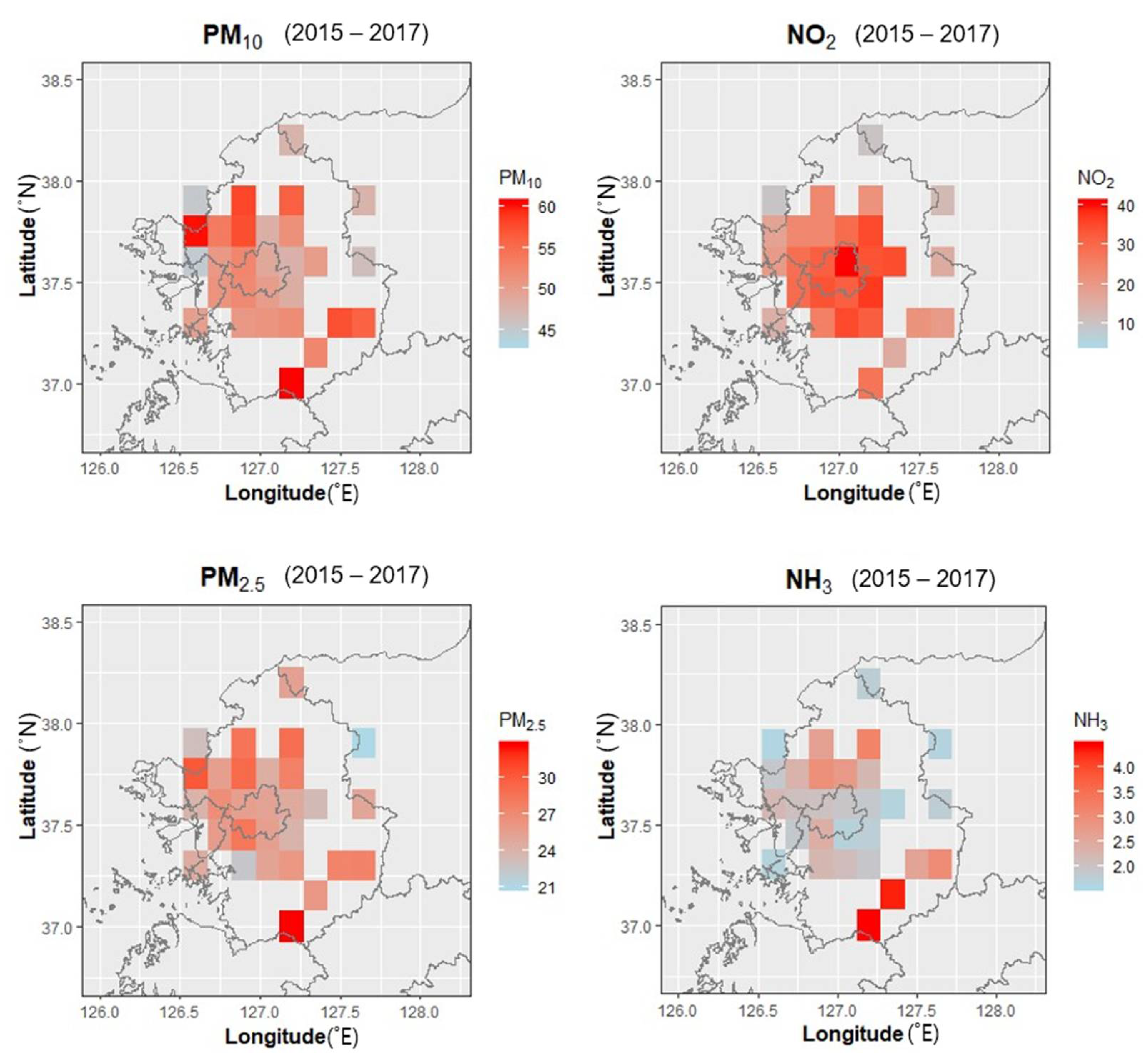
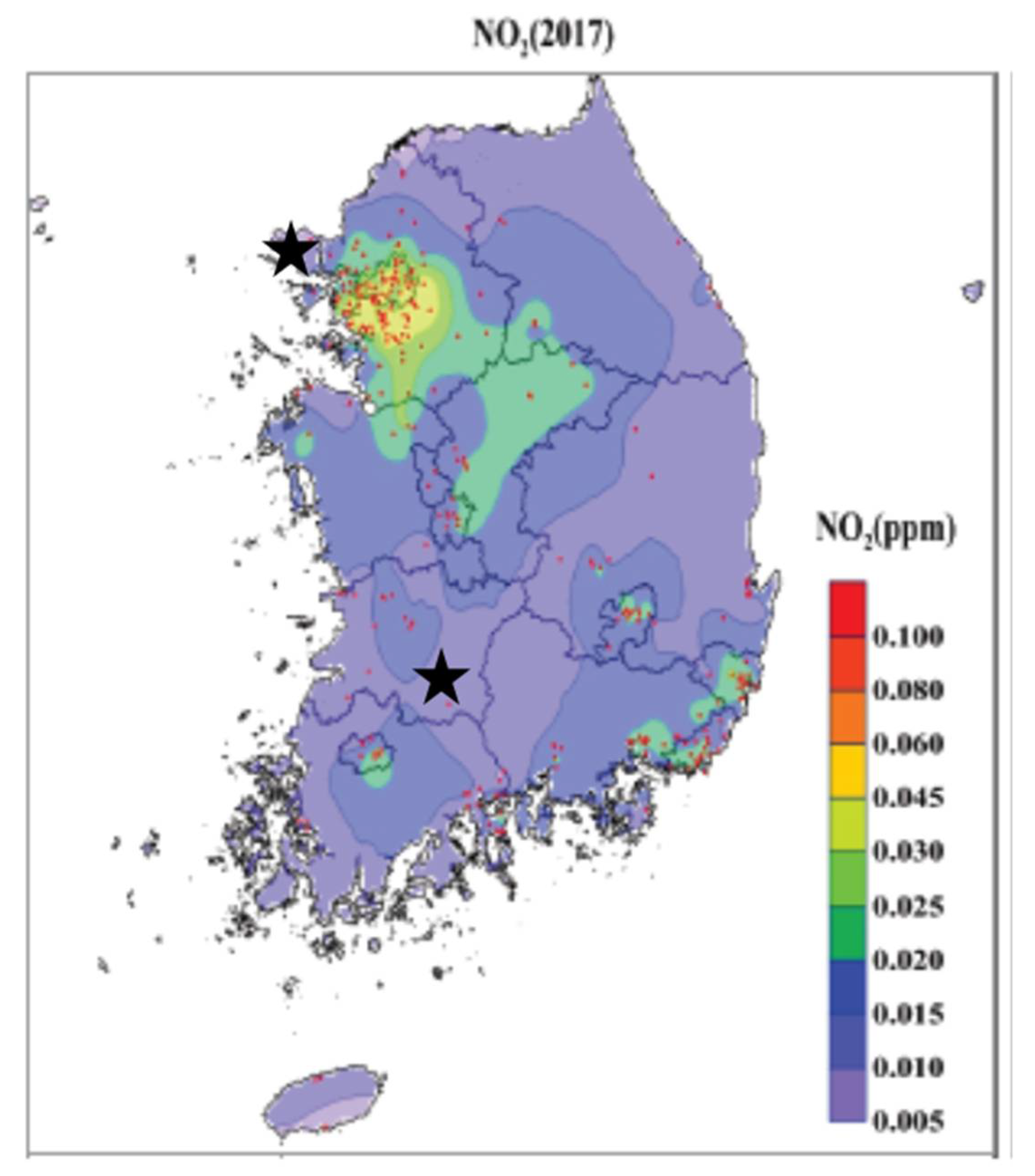
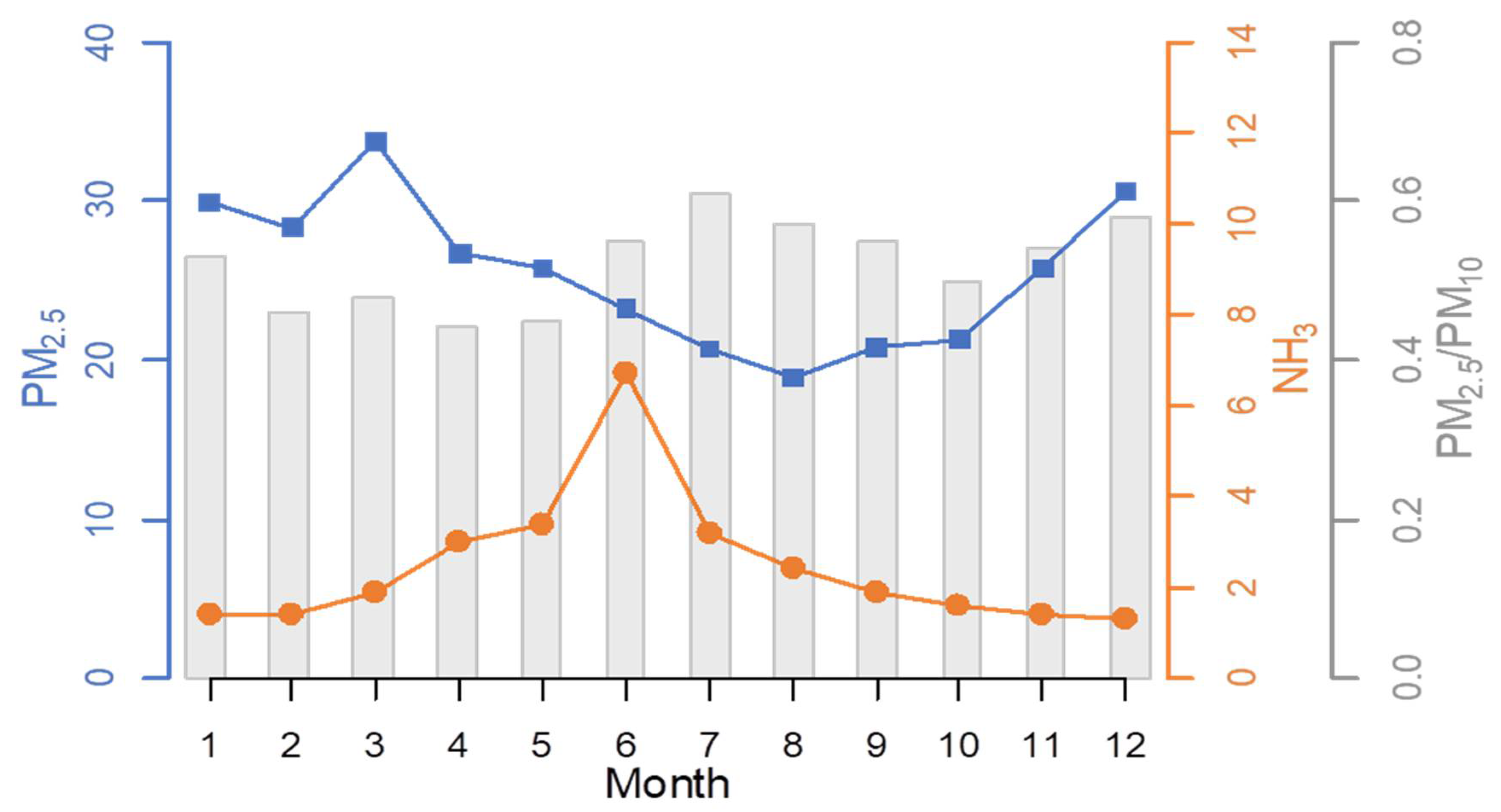
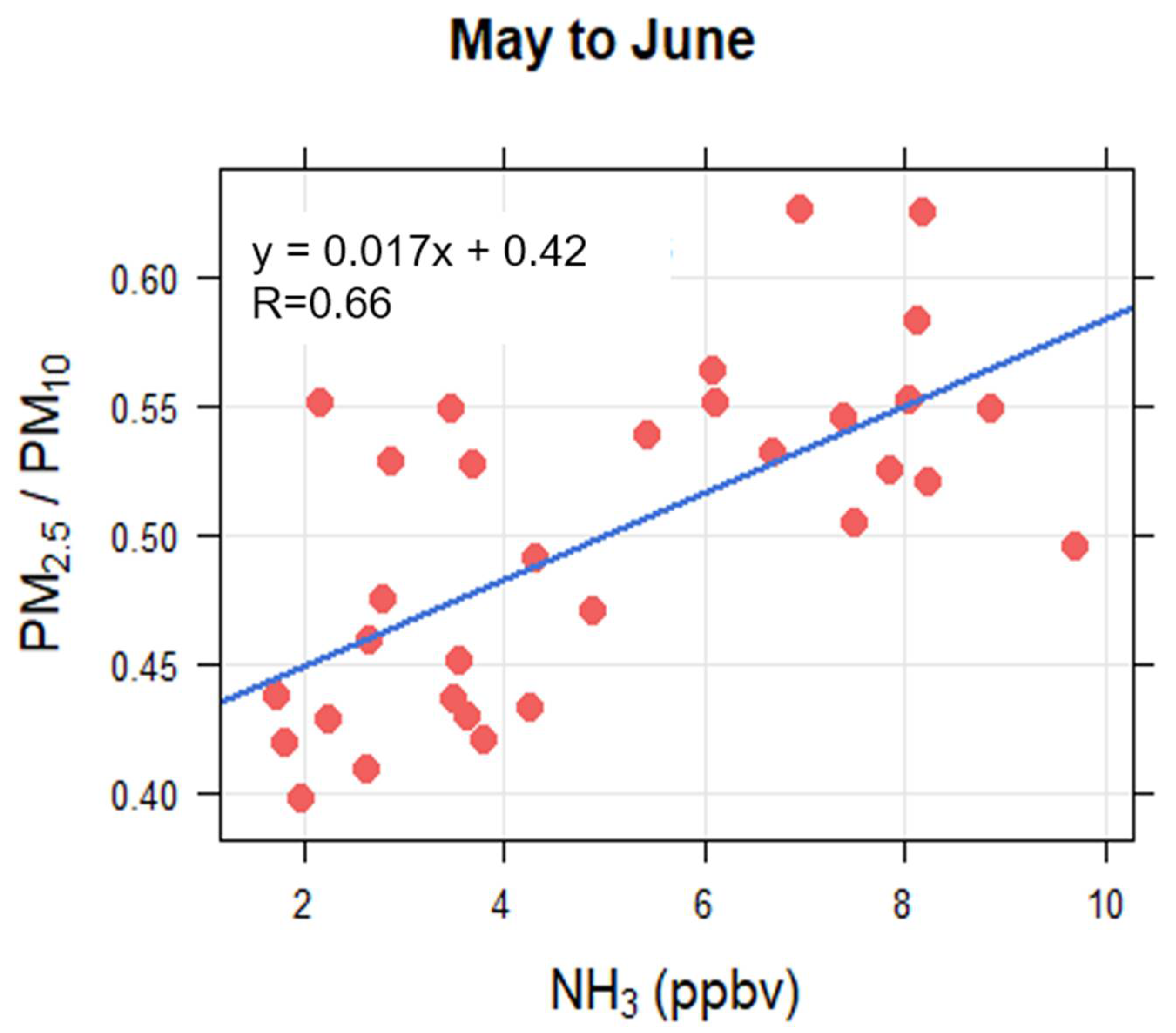
| PM10 | PM2.5 | NH3 | NO2 | SO2 | |
|---|---|---|---|---|---|
| PM10 | 1 | ||||
| PM2.5 | 0.66 (0.60) *** | 1 | |||
| NH3 | 0.32 (0.35) * | 0.51 (0.59) *** | 1 | ||
| NO2 | 0.23 (0.011) | 0.16 (0.09) | −0.022 (0.20) | 1 | |
| SO2 | 0.17 (0.29) | 0.14 (0.17) | −0.015 (0.14) | 0.38 (0.33) ** | 1 |
| Pollutants (Units) | SMA |
|---|---|
| PM10 (µg/m3) | 51 ± 4 |
| PM2.5 (µg/m3) | 26 ± 3 |
| NH3 (ppb) | 2.26 ± 0.7 |
| NO2 (ppb) | 25 ± 9 |
| SO2 (ppb) | 5 ± 1 |
Publisher’s Note: MDPI stays neutral with regard to jurisdictional claims in published maps and institutional affiliations. |
© 2022 by the authors. Licensee MDPI, Basel, Switzerland. This article is an open access article distributed under the terms and conditions of the Creative Commons Attribution (CC BY) license (https://creativecommons.org/licenses/by/4.0/).
Share and Cite
Shim, C.; Han, J.; Henze, D.K.; Shephard, M.W.; Zhu, L.; Moon, N.; Kharol, S.K.; Dammers, E.; Cady-Pereira, K. Impact of NH3 Emissions on Particulate Matter Pollution in South Korea: A Case Study of the Seoul Metropolitan Area. Atmosphere 2022, 13, 1227. https://doi.org/10.3390/atmos13081227
Shim C, Han J, Henze DK, Shephard MW, Zhu L, Moon N, Kharol SK, Dammers E, Cady-Pereira K. Impact of NH3 Emissions on Particulate Matter Pollution in South Korea: A Case Study of the Seoul Metropolitan Area. Atmosphere. 2022; 13(8):1227. https://doi.org/10.3390/atmos13081227
Chicago/Turabian StyleShim, Changsub, Jihyun Han, Daven K. Henze, Mark W. Shephard, Liye Zhu, Nankyoung Moon, Shailesh K. Kharol, Enrico Dammers, and Karen Cady-Pereira. 2022. "Impact of NH3 Emissions on Particulate Matter Pollution in South Korea: A Case Study of the Seoul Metropolitan Area" Atmosphere 13, no. 8: 1227. https://doi.org/10.3390/atmos13081227






